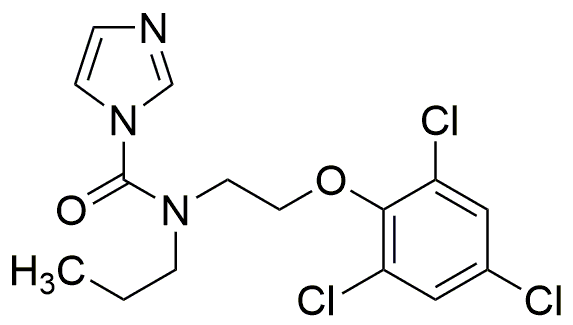Prochloraz is widely utilized in research focused on:
- Agricultural Fungicide: Commonly used to protect crops from fungal diseases, enhancing yield and quality in various crops such as fruits and vegetables.
- Post-Harvest Treatment: Effective in preventing mold and decay in stored grains and fruits, extending shelf life and reducing waste for producers and retailers.
- Research Applications: Utilized in laboratory studies to understand plant-pathogen interactions, aiding researchers in developing more resilient crop varieties.
- Veterinary Medicine: Sometimes used in animal husbandry to control fungal infections in livestock, promoting animal health and productivity.
- Environmental Studies: Investigated for its effects on ecosystems, helping researchers assess the impact of agricultural chemicals on biodiversity and soil health.
General Information
Properties
Safety and Regulations
Applications
Prochloraz is widely utilized in research focused on:
- Agricultural Fungicide: Commonly used to protect crops from fungal diseases, enhancing yield and quality in various crops such as fruits and vegetables.
- Post-Harvest Treatment: Effective in preventing mold and decay in stored grains and fruits, extending shelf life and reducing waste for producers and retailers.
- Research Applications: Utilized in laboratory studies to understand plant-pathogen interactions, aiding researchers in developing more resilient crop varieties.
- Veterinary Medicine: Sometimes used in animal husbandry to control fungal infections in livestock, promoting animal health and productivity.
- Environmental Studies: Investigated for its effects on ecosystems, helping researchers assess the impact of agricultural chemicals on biodiversity and soil health.
Documents
Safety Data Sheets (SDS)
The SDS provides comprehensive safety information on handling, storage, and disposal of the product.
Product Specification (PS)
The PS provides a comprehensive breakdown of the product’s properties, including chemical composition, physical state, purity, and storage requirements. It also details acceptable quality ranges and the product's intended applications.
Certificates of Analysis (COA)
Search for Certificates of Analysis (COA) by entering the products Lot Number. Lot and Batch Numbers can be found on a product’s label following the words ‘Lot’ or ‘Batch’.
*Catalog Number
*Lot Number
Certificates Of Origin (COO)
This COO confirms the country where the product was manufactured, and also details the materials and components used in it and whether it is derived from natural, synthetic, or other specific sources. This certificate may be required for customs, trade, and regulatory compliance.
*Catalog Number
*Lot Number
Safety Data Sheets (SDS)
The SDS provides comprehensive safety information on handling, storage, and disposal of the product.
DownloadProduct Specification (PS)
The PS provides a comprehensive breakdown of the product’s properties, including chemical composition, physical state, purity, and storage requirements. It also details acceptable quality ranges and the product's intended applications.
DownloadCertificates of Analysis (COA)
Search for Certificates of Analysis (COA) by entering the products Lot Number. Lot and Batch Numbers can be found on a product’s label following the words ‘Lot’ or ‘Batch’.
*Catalog Number
*Lot Number
Certificates Of Origin (COO)
This COO confirms the country where the product was manufactured, and also details the materials and components used in it and whether it is derived from natural, synthetic, or other specific sources. This certificate may be required for customs, trade, and regulatory compliance.


